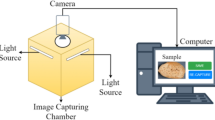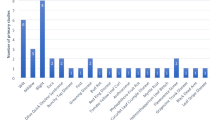Abstract
An efficient plant disease identification is prime important for Agricultural productivity. This paper proposes a method of automatic leaf extraction and classification with improved accuracy compared with existing techniques. Images acquired from natural fields are complex, with background information that needs to be accurately segmented to identify areas of interest. Grab cut is a semi-automatic approach to extract foreground objects, which might occasionally degrade an object’s properties. This paper suggests a better Grab cut for automatically extracting leaves from real-field images. The enhanced dataset of 23,617 images with eleven tomato leaf classes are created using the plant village dataset and actual field images. This paper addresses a wide range of issues related to convolutional neural network optimization, including how the number of layers affects the results of leaf disease detection and the creation of tiny models for portable devices. Five models, VGG 16, MobileNet, and custom architecture with input sizes of 98\(\times\)98, 160\(\times\)160, and 256\(\times\)256, have been optimized and evaluated through several trials. Training and testing involve varying the input size, the number of layers, the optimizer, the dropout, the batch normalization, and the transfer learning. This paper presents and analyzes the findings of thirty experiments on various architecture. The proposed modified sequential eleven-layer architecture achieves accuracy compared with MobileNet and a reduced model size of 3.9 MB for input size 160 and 4.5 MB for input size 98.














Similar content being viewed by others
The data availability statement
The data that support the findings of this study are available from the corresponding author,Shital Karande, upon reasonable request.
References
Khattab D, Ebeid HM, Tolba MF, Hussein AS (2016) Clustering-based image segmentation using automatic grabcut. INFOS ’16, New York, NY. Association for Computing Machinery, pp 95–100
Yann LC, Bengio Y, Hinton G (2015) Deep learning. Nature 521:436–44
Mohanty SP, Hughes DP, Salathé M (2016) Using deep learning for image-based plant disease detection. arXiv:abs/1604.03169
Srdjan S, Marko A, Andras A, Darko S (2016) Deep neural networks based recognition of plant diseases by leaf image classification. Comput Intell Neurosci, 1–11(06):2016
Mamillapally N, Priyanka C (2020) Systematic review of deep learning techniques in plant disease detection. Int J Syst Assuran Eng Manage 11:05
Sabrol H, Satish K (2016) Tomato plant disease classification in digital images using classification tree. In: 2016 international conference on communication and signal processing (ICCSP), pp 1242–1246
Petrellis N (2017) Mobile application for plant disease classification based on symptom signatures. In: Proceedings of the 21st Pan-Hellenic conference on informatics
Vijai S, Misra AK (2016) Detection of plant leaf diseases using image segmentation and soft computing techniques. Inf Process Agric 4:11
Xuebing B, Xinxing Li F, Zetian LX, Lingxian Z (2017) A fuzzy clustering segmentation method based on neighborhood grayscale information for defining cucumber leaf spot disease images. Comput Electron Agric 136(157–165):04
Pascual E, Plaza J, Tesorero J, Goma J (2019) Disease detection of Asian rice (Oryza sativa) in the Philippines using image processing, pp. 131–135, 10
Chad DC, Tyr W-H, Siyuan C, Ethan S, Jason Y, Michael G, Rebecca N, Hod L (2017) Automated identification of northern leaf blight-infected maize plants from field imagery using deep learning. Phytopathology 107:1426–1432
Mohammed B, Boukhalfa K, Abdelouahab M (2017) Deep learning for tomato diseases: Classification and symptoms visualization. Appl Artif Intell 31:1–17
Rocha E, Rodrigues Moreira L, Mari J (2019) Maize leaf disease classification using convolutional neural networks and hyperparameter optimization. 05
Ramcharan A, Baranowski K, McCloskey P, Ahmed B, Legg J, Hughes DP (2017) Deep learning for image-based cassava disease detection. Front Plant Sci 8
Fuentes AF, Yoon S, Lee J, Park DS (2018) High-performance deep neural network-based tomato plant diseases and pests diagnosis system with refinement filter bank. Front Plant Sci 9
Mohammed B, Boukhalfa K, Abdelouahab M (2017) Deep learning for tomato diseases: Classification and symptoms visualization. Appl Artif Intell 31:1–17
Howard AG, Zhu M, Chen B, Kalenichenko D, Wang W, Weyand T, Andreetto M, Adam H (2017) Mobilenets: efficient convolutional neural networks for mobile vision applications. arXiv:1704.04861,
Xihai Z, Yue Q, Fanfeng M, Chengguo F, Mingming Z (2018) Identification of maize leaf diseases using improved deep convolutional neural networks. IEEE Access 6:30370–30377
Konstantinos F (2018) Deep learning models for plant disease detection and diagnosis. Comput Electron Agric 145:311–318
Ramesh A (2019) Tomato crop disease classification using pre-trained deep learning algorithm. 03
Shanwen Z, Zhu-Hong Y, Xiaowei W (2019) Plant disease leaf image segmentation based on superpixel clustering and em algorithm. Neural Comput Appl 31:02
Hlaing CS, Maung Zaw SM (2018) Tomato plant diseases classification using statistical texture feature and color feature. In: 2018 IEEE/ACIS 17th international conference on computer and information science (ICIS), pp 439–444
Attique KM, Ikram LM, Ullah SM, Kashif J, Khursheed A, Irtaza HS, Saud AA, Talha A (2019) An optimized method for segmentation and classification of apple diseases based on strong correlation and genetic algorithm based feature selection. IEEE Access 7:46261–46277
Sinan U, Nese U (2020) Classification of olive leaf diseases using deep convolutional neural networks. Neural Comput Appl 33:07
Jakjoud F, Anas H, Bouaaddi A (2019) Deep learning application for plant diseases detection, vol 10, pp 1–6,
Selvaraj MG, Vergara A, Ruiz Guzman H, Safari N, Elayabalan S, Ocimati W, Blomme G (2019) Ai-powered banana diseases and pest detection. Plant Methods 15:08
Marko A, Mirjana K, Srdjan S, Andras A, Darko S (2019) Solving current limitations of deep learning based approaches for plant disease detection. Symmetry 11(21):07
Geetharamani G, Arun Pandian J (2019) Identification of plant leaf diseases using a nine layer deep convolutional neural network. Comput Electr Eng 76:323–338
Belal A, Samy A-N (2019) Image-based tomato leaves diseases detection using deep learning. Int J Eng Res 2:10–16
Belal A, Samy A-N (2019) Image-based tomato leaves diseases detection using deep learning. Int J Eng Res 2:10–16
Sembiring A, Away Y, Arnia F, Muharar R (1845) Development of concise convolutional neural network for tomato plant disease classification based on leaf images. J Phys Confer Ser 012009(03):(2021)
Sambasivam G, Geoffrey O (2020) A predictive machine learning application in agriculture: Cassava disease detection and classification with imbalanced dataset using convolutional neural networks. Egypt Inf J 22:03
Hang Yu-Xiu Zhang, Guanhua C, Wang B (2019) Classification of plant leaf diseases based on improved convolutional neural network. Sensors 19:4161
Muhammad S, Potgieter J, Khalid A (2019) Plant disease detection and classification by deep learning. Plants 8(468):10
Hasanul K, Redwan S, Bakhtiar H, Tasnim A, Sabbir A (2022) Less is more: Lighter and faster deep neural architecture for tomato leaf disease classification. IEEE Access 10:07
Yashwant K, Suchi G (2022) A leaf image localization based algorithm for different crops disease classification. Inf Process Agric 9(3):456–474
Yonghua X, Longfei L, Lin W, Jinhua S, Min W (2020) Identification of cash crop diseases using automatic image segmentation algorithm and deep learning with expanded dataset. Comput Electron Agric 177:105712
Jadhav Shital GB (2022) Comparative analysis of image segmentation techniques for real field crop images, pp 1–9. 09
Bindu G, Shital J (2022) Comprehensive review on machine learning for plant disease identification and classification with image processing. In: Proceedings of international conference on intelligent cyber-physical systems. algorithms for intelligent systems. Springer, Singapore, pp 247–262. 01
Pintelas E, Liaskos M, Livieris I, Kotsiantis S, Pintelas P (2021) A novel explainable image classification framework: case study on skin cancer and plant disease prediction. Neural Comput Appl 33:11
Funding
This research did not receive any specific grant from funding agencies in the public, commercial, or not-for-profit sectors.
Author information
Authors and Affiliations
Corresponding author
Ethics declarations
Conflict of interest
The authors declared that they have no conflicts of interest to this work. We declare that we do not have any commercial or associative interest that represents a Conflict of interest in connection with the work submitted.
Additional information
Publisher's Note
Springer Nature remains neutral with regard to jurisdictional claims in published maps and institutional affiliations.
Rights and permissions
Springer Nature or its licensor (e.g. a society or other partner) holds exclusive rights to this article under a publishing agreement with the author(s) or other rightsholder(s); author self-archiving of the accepted manuscript version of this article is solely governed by the terms of such publishing agreement and applicable law.
About this article
Cite this article
Karande, S., Garg, B. Performance evaluation and optimization of convolutional neural network architectures for Tomato plant disease eleven classes based on augmented leaf images dataset. Neural Comput & Applic (2024). https://doi.org/10.1007/s00521-024-09670-6
Received:
Accepted:
Published:
DOI: https://doi.org/10.1007/s00521-024-09670-6




